Comprehensive Analysis: The Alibaba Business Model and Strategy
VerifiedAdded on 2021/06/16
|7
|1437
|181
Report
AI Summary
This report provides a comprehensive analysis of the Alibaba business model, exploring its evolution and key components. It begins by defining relationship marketing and its significance in business success, setting the stage for an examination of Alibaba's strategies. The report delves into Alibaba's history, its e-commerce platforms (Alibaba.com, Taobao, and Tmall), and its subsidiaries, illustrating how they collectively form a self-sustaining ecosystem. The analysis highlights Alibaba's approach to the postmodern business landscape, emphasizing its use of technology and its focus on customer relationships. The report also discusses the benefits of Alibaba's business-to-business model, such as product partnerships and credit worthiness, while also addressing the challenges the company faces, including counterfeit products and taxation issues. The report concludes by emphasizing Alibaba's role as an innovator in online and offline commerce and its ongoing efforts to optimize business-to-business relationships.

Running head: THE ALIBABA BUSINESS MODEL 1
Student name
Institution affiliation
The Alibaba business model
Student name
Institution affiliation
The Alibaba business model
Paraphrase This Document
Need a fresh take? Get an instant paraphrase of this document with our AI Paraphraser
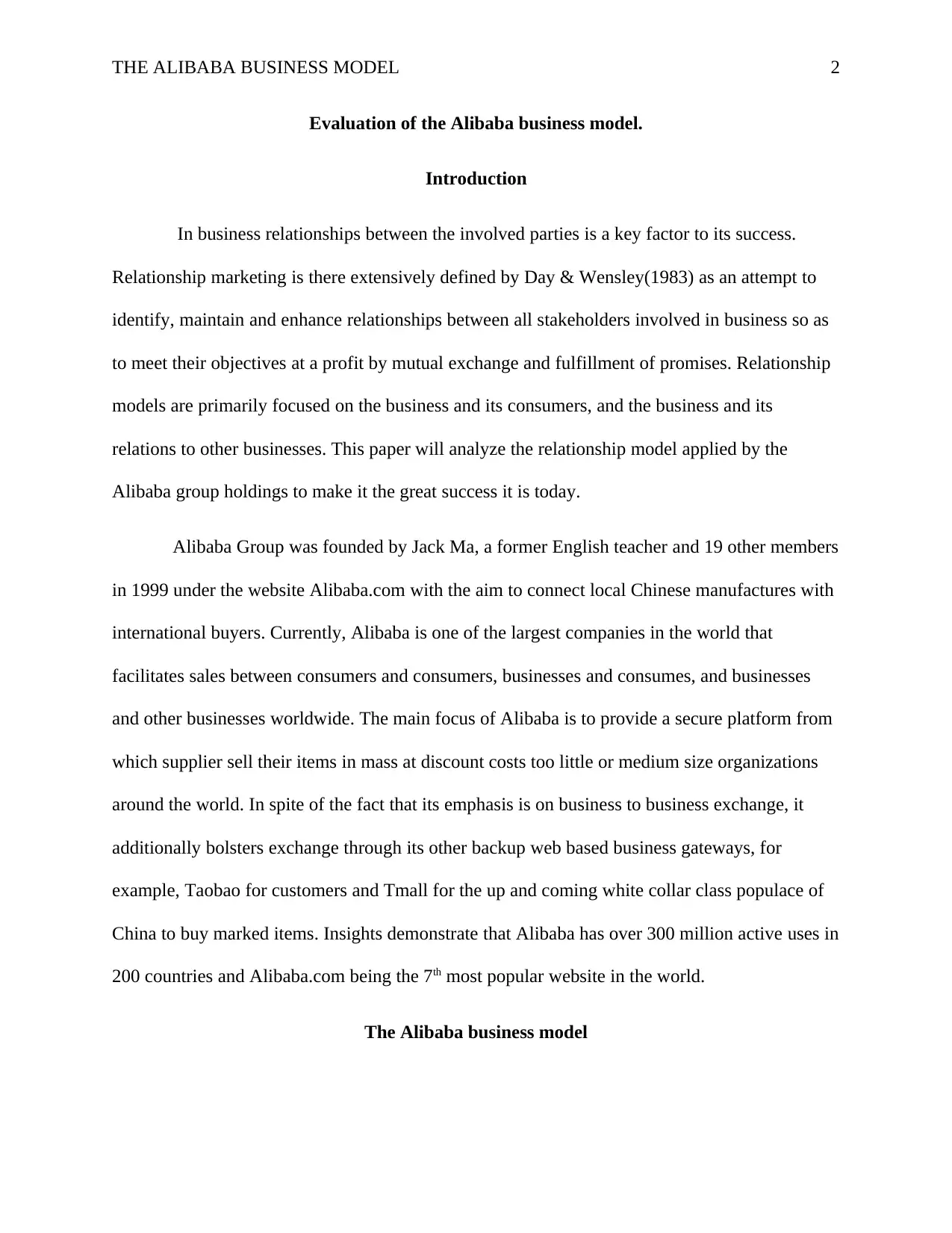
THE ALIBABA BUSINESS MODEL 2
Evaluation of the Alibaba business model.
Introduction
In business relationships between the involved parties is a key factor to its success.
Relationship marketing is there extensively defined by Day & Wensley(1983) as an attempt to
identify, maintain and enhance relationships between all stakeholders involved in business so as
to meet their objectives at a profit by mutual exchange and fulfillment of promises. Relationship
models are primarily focused on the business and its consumers, and the business and its
relations to other businesses. This paper will analyze the relationship model applied by the
Alibaba group holdings to make it the great success it is today.
Alibaba Group was founded by Jack Ma, a former English teacher and 19 other members
in 1999 under the website Alibaba.com with the aim to connect local Chinese manufactures with
international buyers. Currently, Alibaba is one of the largest companies in the world that
facilitates sales between consumers and consumers, businesses and consumes, and businesses
and other businesses worldwide. The main focus of Alibaba is to provide a secure platform from
which supplier sell their items in mass at discount costs too little or medium size organizations
around the world. In spite of the fact that its emphasis is on business to business exchange, it
additionally bolsters exchange through its other backup web based business gateways, for
example, Taobao for customers and Tmall for the up and coming white collar class populace of
China to buy marked items. Insights demonstrate that Alibaba has over 300 million active uses in
200 countries and Alibaba.com being the 7th most popular website in the world.
The Alibaba business model
Evaluation of the Alibaba business model.
Introduction
In business relationships between the involved parties is a key factor to its success.
Relationship marketing is there extensively defined by Day & Wensley(1983) as an attempt to
identify, maintain and enhance relationships between all stakeholders involved in business so as
to meet their objectives at a profit by mutual exchange and fulfillment of promises. Relationship
models are primarily focused on the business and its consumers, and the business and its
relations to other businesses. This paper will analyze the relationship model applied by the
Alibaba group holdings to make it the great success it is today.
Alibaba Group was founded by Jack Ma, a former English teacher and 19 other members
in 1999 under the website Alibaba.com with the aim to connect local Chinese manufactures with
international buyers. Currently, Alibaba is one of the largest companies in the world that
facilitates sales between consumers and consumers, businesses and consumes, and businesses
and other businesses worldwide. The main focus of Alibaba is to provide a secure platform from
which supplier sell their items in mass at discount costs too little or medium size organizations
around the world. In spite of the fact that its emphasis is on business to business exchange, it
additionally bolsters exchange through its other backup web based business gateways, for
example, Taobao for customers and Tmall for the up and coming white collar class populace of
China to buy marked items. Insights demonstrate that Alibaba has over 300 million active uses in
200 countries and Alibaba.com being the 7th most popular website in the world.
The Alibaba business model
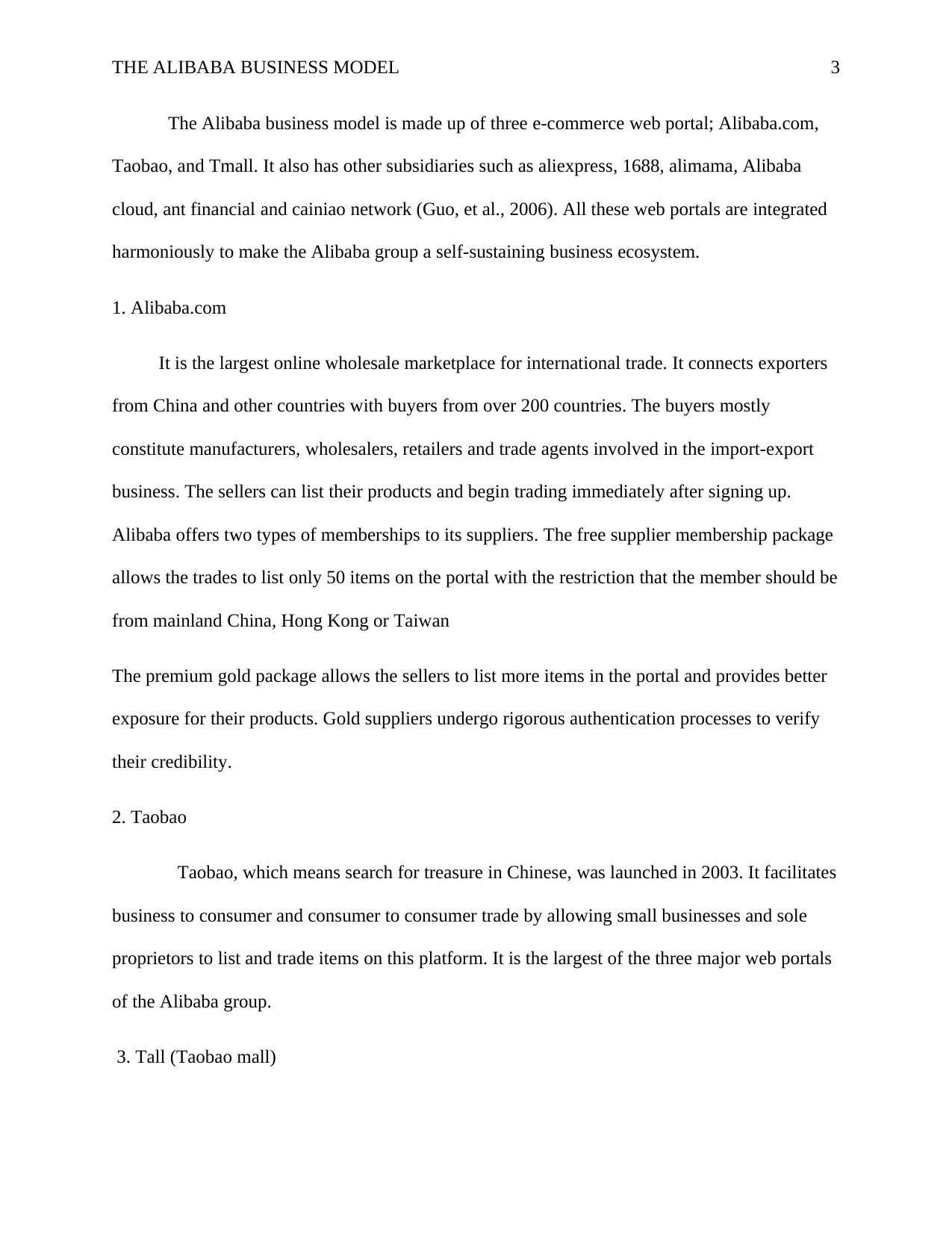
THE ALIBABA BUSINESS MODEL 3
The Alibaba business model is made up of three e-commerce web portal; Alibaba.com,
Taobao, and Tmall. It also has other subsidiaries such as aliexpress, 1688, alimama, Alibaba
cloud, ant financial and cainiao network (Guo, et al., 2006). All these web portals are integrated
harmoniously to make the Alibaba group a self-sustaining business ecosystem.
1. Alibaba.com
It is the largest online wholesale marketplace for international trade. It connects exporters
from China and other countries with buyers from over 200 countries. The buyers mostly
constitute manufacturers, wholesalers, retailers and trade agents involved in the import-export
business. The sellers can list their products and begin trading immediately after signing up.
Alibaba offers two types of memberships to its suppliers. The free supplier membership package
allows the trades to list only 50 items on the portal with the restriction that the member should be
from mainland China, Hong Kong or Taiwan
The premium gold package allows the sellers to list more items in the portal and provides better
exposure for their products. Gold suppliers undergo rigorous authentication processes to verify
their credibility.
2. Taobao
Taobao, which means search for treasure in Chinese, was launched in 2003. It facilitates
business to consumer and consumer to consumer trade by allowing small businesses and sole
proprietors to list and trade items on this platform. It is the largest of the three major web portals
of the Alibaba group.
3. Tall (Taobao mall)
The Alibaba business model is made up of three e-commerce web portal; Alibaba.com,
Taobao, and Tmall. It also has other subsidiaries such as aliexpress, 1688, alimama, Alibaba
cloud, ant financial and cainiao network (Guo, et al., 2006). All these web portals are integrated
harmoniously to make the Alibaba group a self-sustaining business ecosystem.
1. Alibaba.com
It is the largest online wholesale marketplace for international trade. It connects exporters
from China and other countries with buyers from over 200 countries. The buyers mostly
constitute manufacturers, wholesalers, retailers and trade agents involved in the import-export
business. The sellers can list their products and begin trading immediately after signing up.
Alibaba offers two types of memberships to its suppliers. The free supplier membership package
allows the trades to list only 50 items on the portal with the restriction that the member should be
from mainland China, Hong Kong or Taiwan
The premium gold package allows the sellers to list more items in the portal and provides better
exposure for their products. Gold suppliers undergo rigorous authentication processes to verify
their credibility.
2. Taobao
Taobao, which means search for treasure in Chinese, was launched in 2003. It facilitates
business to consumer and consumer to consumer trade by allowing small businesses and sole
proprietors to list and trade items on this platform. It is the largest of the three major web portals
of the Alibaba group.
3. Tall (Taobao mall)
⊘ This is a preview!⊘
Do you want full access?
Subscribe today to unlock all pages.

Trusted by 1+ million students worldwide
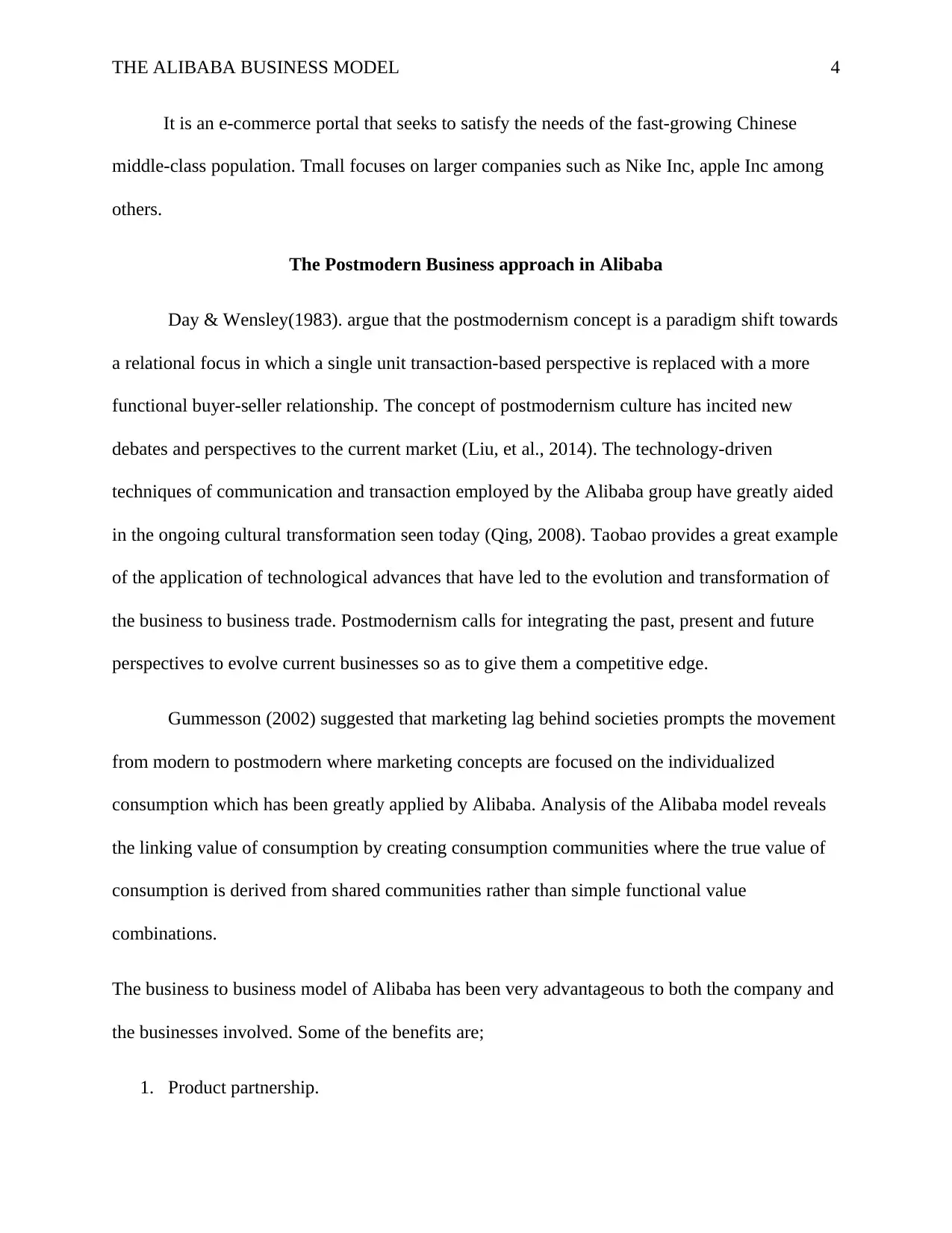
THE ALIBABA BUSINESS MODEL 4
It is an e-commerce portal that seeks to satisfy the needs of the fast-growing Chinese
middle-class population. Tmall focuses on larger companies such as Nike Inc, apple Inc among
others.
The Postmodern Business approach in Alibaba
Day & Wensley(1983). argue that the postmodernism concept is a paradigm shift towards
a relational focus in which a single unit transaction-based perspective is replaced with a more
functional buyer-seller relationship. The concept of postmodernism culture has incited new
debates and perspectives to the current market (Liu, et al., 2014). The technology-driven
techniques of communication and transaction employed by the Alibaba group have greatly aided
in the ongoing cultural transformation seen today (Qing, 2008). Taobao provides a great example
of the application of technological advances that have led to the evolution and transformation of
the business to business trade. Postmodernism calls for integrating the past, present and future
perspectives to evolve current businesses so as to give them a competitive edge.
Gummesson (2002) suggested that marketing lag behind societies prompts the movement
from modern to postmodern where marketing concepts are focused on the individualized
consumption which has been greatly applied by Alibaba. Analysis of the Alibaba model reveals
the linking value of consumption by creating consumption communities where the true value of
consumption is derived from shared communities rather than simple functional value
combinations.
The business to business model of Alibaba has been very advantageous to both the company and
the businesses involved. Some of the benefits are;
1. Product partnership.
It is an e-commerce portal that seeks to satisfy the needs of the fast-growing Chinese
middle-class population. Tmall focuses on larger companies such as Nike Inc, apple Inc among
others.
The Postmodern Business approach in Alibaba
Day & Wensley(1983). argue that the postmodernism concept is a paradigm shift towards
a relational focus in which a single unit transaction-based perspective is replaced with a more
functional buyer-seller relationship. The concept of postmodernism culture has incited new
debates and perspectives to the current market (Liu, et al., 2014). The technology-driven
techniques of communication and transaction employed by the Alibaba group have greatly aided
in the ongoing cultural transformation seen today (Qing, 2008). Taobao provides a great example
of the application of technological advances that have led to the evolution and transformation of
the business to business trade. Postmodernism calls for integrating the past, present and future
perspectives to evolve current businesses so as to give them a competitive edge.
Gummesson (2002) suggested that marketing lag behind societies prompts the movement
from modern to postmodern where marketing concepts are focused on the individualized
consumption which has been greatly applied by Alibaba. Analysis of the Alibaba model reveals
the linking value of consumption by creating consumption communities where the true value of
consumption is derived from shared communities rather than simple functional value
combinations.
The business to business model of Alibaba has been very advantageous to both the company and
the businesses involved. Some of the benefits are;
1. Product partnership.
Paraphrase This Document
Need a fresh take? Get an instant paraphrase of this document with our AI Paraphraser

THE ALIBABA BUSINESS MODEL 5
Alibaba has provided virtual products that develop a convenient and efficient management
structure for the exporters to update important information freely to enable the buyers to
contact the suppliers easily (Day, and Wensley, 1983). Businesses, therefore, have a chance
to examine thoroughly the credentials of a company before engaging in any transaction.
2. Credit worthiness
The development of Alipay in China was a major contributor to its success. The payment
system restored the trust of both the buyers and sellers by reducing risks of e-
transactions, ensuring the security of their funds from a transaction and enacting policies
to deal with the failure of delivery or delivery of damaged goods.
3. Maintaining contact with the customers
Alibaba provides forums, blogs and user groups where customers can communicate and
get feedback on their interests. Businesses can also keep in touch and get any feedback on
the quality and quantity of product desired by the clients.
Despite its success, Alibaba faces challenges in its business. Some of the aforementioned
challenges include;
1. Counterfeit products
Alibaba’s greatest challenge is the sale of counterfeit products. Although the company has
enacted strategies to ensure quality goods are sold, most consumers do not trust the portal as
some merchants especially from Hongkong low-quality goods which are highlighted attractive
advertisements. This tarnishes the company name.
Alibaba has provided virtual products that develop a convenient and efficient management
structure for the exporters to update important information freely to enable the buyers to
contact the suppliers easily (Day, and Wensley, 1983). Businesses, therefore, have a chance
to examine thoroughly the credentials of a company before engaging in any transaction.
2. Credit worthiness
The development of Alipay in China was a major contributor to its success. The payment
system restored the trust of both the buyers and sellers by reducing risks of e-
transactions, ensuring the security of their funds from a transaction and enacting policies
to deal with the failure of delivery or delivery of damaged goods.
3. Maintaining contact with the customers
Alibaba provides forums, blogs and user groups where customers can communicate and
get feedback on their interests. Businesses can also keep in touch and get any feedback on
the quality and quantity of product desired by the clients.
Despite its success, Alibaba faces challenges in its business. Some of the aforementioned
challenges include;
1. Counterfeit products
Alibaba’s greatest challenge is the sale of counterfeit products. Although the company has
enacted strategies to ensure quality goods are sold, most consumers do not trust the portal as
some merchants especially from Hongkong low-quality goods which are highlighted attractive
advertisements. This tarnishes the company name.
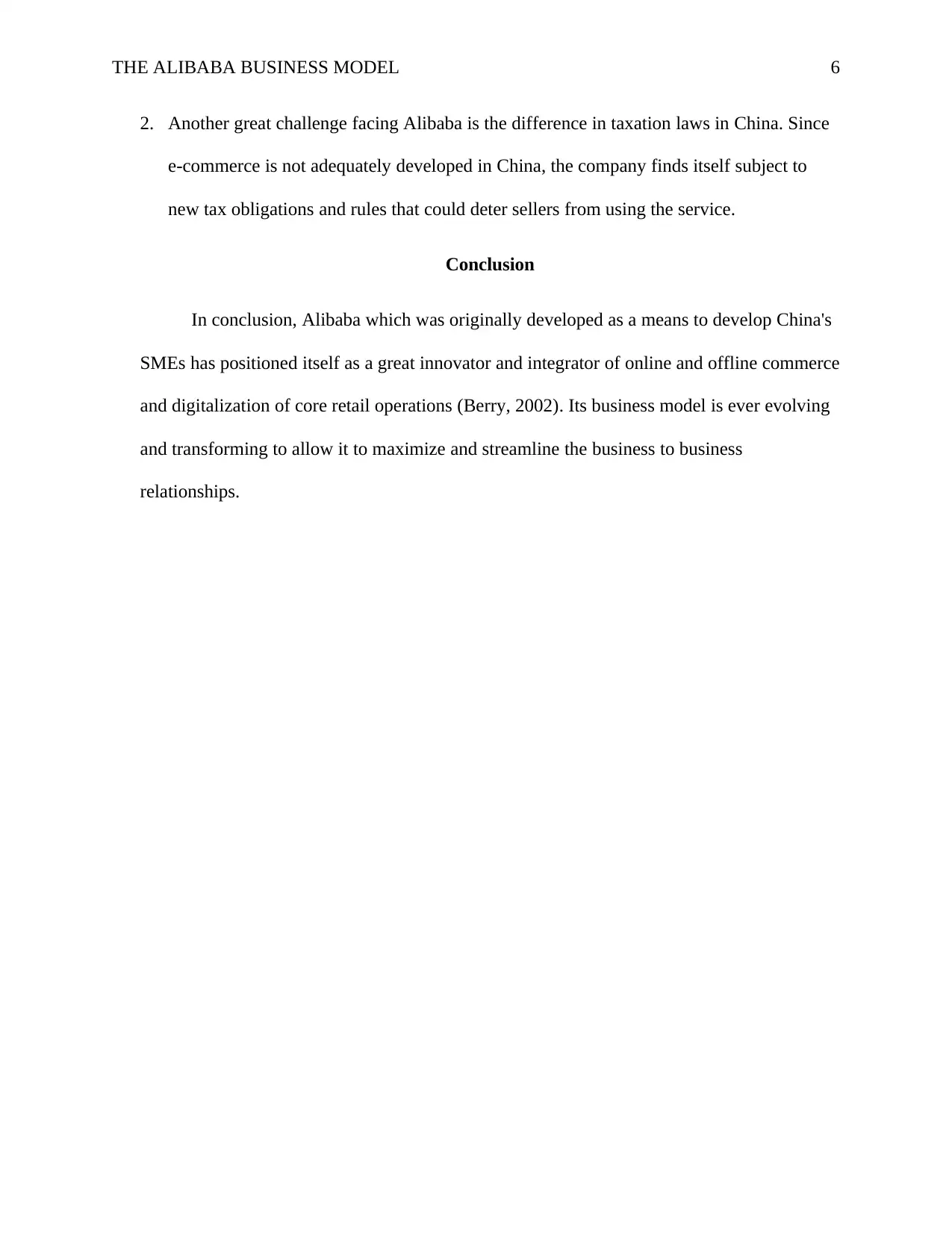
THE ALIBABA BUSINESS MODEL 6
2. Another great challenge facing Alibaba is the difference in taxation laws in China. Since
e-commerce is not adequately developed in China, the company finds itself subject to
new tax obligations and rules that could deter sellers from using the service.
Conclusion
In conclusion, Alibaba which was originally developed as a means to develop China's
SMEs has positioned itself as a great innovator and integrator of online and offline commerce
and digitalization of core retail operations (Berry, 2002). Its business model is ever evolving
and transforming to allow it to maximize and streamline the business to business
relationships.
2. Another great challenge facing Alibaba is the difference in taxation laws in China. Since
e-commerce is not adequately developed in China, the company finds itself subject to
new tax obligations and rules that could deter sellers from using the service.
Conclusion
In conclusion, Alibaba which was originally developed as a means to develop China's
SMEs has positioned itself as a great innovator and integrator of online and offline commerce
and digitalization of core retail operations (Berry, 2002). Its business model is ever evolving
and transforming to allow it to maximize and streamline the business to business
relationships.
⊘ This is a preview!⊘
Do you want full access?
Subscribe today to unlock all pages.

Trusted by 1+ million students worldwide
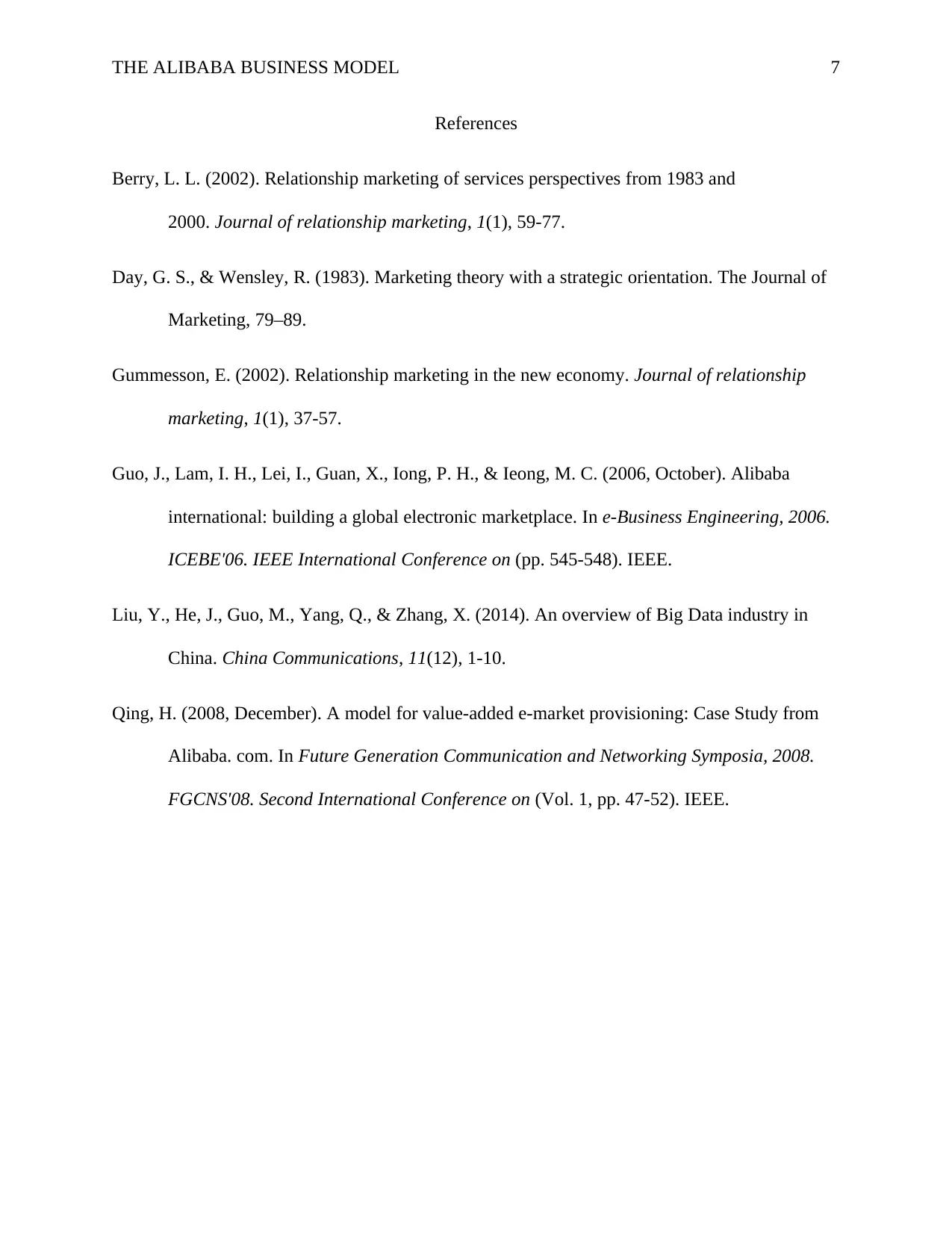
THE ALIBABA BUSINESS MODEL 7
References
Berry, L. L. (2002). Relationship marketing of services perspectives from 1983 and
2000. Journal of relationship marketing, 1(1), 59-77.
Day, G. S., & Wensley, R. (1983). Marketing theory with a strategic orientation. The Journal of
Marketing, 79–89.
Gummesson, E. (2002). Relationship marketing in the new economy. Journal of relationship
marketing, 1(1), 37-57.
Guo, J., Lam, I. H., Lei, I., Guan, X., Iong, P. H., & Ieong, M. C. (2006, October). Alibaba
international: building a global electronic marketplace. In e-Business Engineering, 2006.
ICEBE'06. IEEE International Conference on (pp. 545-548). IEEE.
Liu, Y., He, J., Guo, M., Yang, Q., & Zhang, X. (2014). An overview of Big Data industry in
China. China Communications, 11(12), 1-10.
Qing, H. (2008, December). A model for value-added e-market provisioning: Case Study from
Alibaba. com. In Future Generation Communication and Networking Symposia, 2008.
FGCNS'08. Second International Conference on (Vol. 1, pp. 47-52). IEEE.
References
Berry, L. L. (2002). Relationship marketing of services perspectives from 1983 and
2000. Journal of relationship marketing, 1(1), 59-77.
Day, G. S., & Wensley, R. (1983). Marketing theory with a strategic orientation. The Journal of
Marketing, 79–89.
Gummesson, E. (2002). Relationship marketing in the new economy. Journal of relationship
marketing, 1(1), 37-57.
Guo, J., Lam, I. H., Lei, I., Guan, X., Iong, P. H., & Ieong, M. C. (2006, October). Alibaba
international: building a global electronic marketplace. In e-Business Engineering, 2006.
ICEBE'06. IEEE International Conference on (pp. 545-548). IEEE.
Liu, Y., He, J., Guo, M., Yang, Q., & Zhang, X. (2014). An overview of Big Data industry in
China. China Communications, 11(12), 1-10.
Qing, H. (2008, December). A model for value-added e-market provisioning: Case Study from
Alibaba. com. In Future Generation Communication and Networking Symposia, 2008.
FGCNS'08. Second International Conference on (Vol. 1, pp. 47-52). IEEE.
1 out of 7
Related Documents
Your All-in-One AI-Powered Toolkit for Academic Success.
+13062052269
info@desklib.com
Available 24*7 on WhatsApp / Email
![[object Object]](/_next/static/media/star-bottom.7253800d.svg)
Unlock your academic potential
Copyright © 2020–2025 A2Z Services. All Rights Reserved. Developed and managed by ZUCOL.





